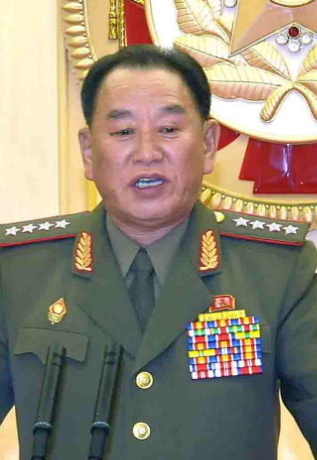[Newsmaker] Why did N.K. chief join inter-Korean talks?
By Korea HeraldPublished : Oct. 16, 2014 - 21:24
The appearance of North Korea’s military spy chief Kim Yong-chol at rare inter-Korean military talks on Wednesday has left many observers wondering what message Pyongyang wanted to convey through sending the hawkish figure.
Some analysts argued that the head of the Reconnaissance General Bureau, well-known for spearheading provocations against the South, attended the talks to show Pyongyang’s resolve to reconcile and improve cross-border relations.
Some analysts argued that the head of the Reconnaissance General Bureau, well-known for spearheading provocations against the South, attended the talks to show Pyongyang’s resolve to reconcile and improve cross-border relations.

Others said that the appearance of the spy chief underscored the North’s determination to maintain its adamant position over a series of pending defense issues including heightened tensions surrounding the Northern Limit Line, a de facto maritime border.
The military talks at the inter-Korean border village of Panmunjeom came as the North stepped up pressure on the South to lift its so-called May 24 measures that ban any economic exchanges with the North. The measures were put in place after the North torpedoed the South Korean corvette the Cheonan in March 2010, killing 46 sailors.
Despite evidence found by the South-led international investigation team, the North has denied responsibility for the torpedo attack, while the South has called for an official apology and “responsible measures” as the conditions for lifting the May 24 sanctions.
Amid varied expert analyses, Seoul officials appeared to view Wednesday’s talks as a positive sign that the North was trying to resolve pending inter-Korean issues through dialogue.
“It is hard to judge their intentions right away. We need to wait and see, but there really was a sign that the North is willing to improve bilateral relations,” a Seoul official told The Korea Herald, declining to be named.
Kim’s Reconnaissance General Bureau is believed to have masterminded a series of attacks against the South, both online and offline.
The attacks include the shelling of Yeonpyeongdo Island in 2010 and a massive cyberattack in 2011 that paralyzed the banking system of the National Agricultural Cooperative Federation for several weeks. Seoul also believes that the RGB was responsible for a series of disruptions of satellite traffic navigation signals from 2010 to 2012.
Given the RGB’s track record of provocations, some observers remained skeptical about the intentions behind the North’s proposal of military talks. But Hong Hyun-ik, senior researcher at the think tank Sejong Institute, offered a positive analysis.
“As Kim Yong-chol is the one who can directly talk to the North Korean leader, and the one that the South blames for the sinking of the Cheonan, his appearance at the talks indicates that the North may want to tackle the issue in a straightforward manner and seek a compromise,” he said.
After North Korean leader Kim Jong-un took power in December 2011 upon the death of his father Kim Jong-il, Kim Yong-chol was demoted temporarily to two-star status, which sparked speculation that he might not be in the North Korean leader’s inner circle. But he regained his four-star insignia in early 2013, proving that he was one of the most-trusted figures.
The RGB was launched as a control tower for military spy operations against the South in 2009 after several state and party organizations with similar functions were merged, such as the ruling Worker’s Party’s Room 35, which ran overseas spy operations.
By Song Sang-ho (sshluck@heraldcorp.com)
-
Articles by Korea Herald











![[Today’s K-pop] BTS pop-up event to come to Seoul](http://res.heraldm.com/phpwas/restmb_idxmake.php?idx=644&simg=/content/image/2024/04/17/20240417050734_0.jpg&u=)





![[KH Explains] Hyundai's full hybrid edge to pay off amid slow transition to pure EVs](http://res.heraldm.com/phpwas/restmb_idxmake.php?idx=652&simg=/content/image/2024/04/18/20240418050645_0.jpg&u=20240419100350)

